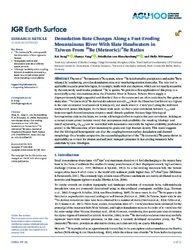Denudation Rate Changes Along a Fast‐Eroding Mountainous River With Slate Headwaters in Taiwan From 10Be (Meteoric)/9Be Ratios
DOI: https://doi.org/10.1029/2019JF005251
Persistent URL: http://resolver.sub.uni-goettingen.de/purl?gldocs-11858/9845
Persistent URL: http://resolver.sub.uni-goettingen.de/purl?gldocs-11858/9845
Deng, Kai; Yang, Shouye; von Blanckenburg, Friedhelm; Wittmann, Hella, 2020: Denudation Rate Changes Along a Fast‐Eroding Mountainous River With Slate Headwaters in Taiwan From 10Be (Meteoric)/9Be Ratios. In: Journal of Geophysical Research: Earth Surface, Band 125, 2, DOI: 10.1029/2019JF005251.
 |
Dokument öffnen: |
The novel 10Be (meteoric)/9Be system, where 10Be is delivered by precipitation and stable 9Be is released by weathering, provides denudation rates over weathering‐erosion timescales. The new tool is applicable to quartz‐poor lithologies, for example, mafic rock and claystone, which are not readily accessible by the commonly used in situ‐produced 10Be in quartz. We provide a first application of this proxy to a tectonically active mountainous river, the Zhuoshui River in Taiwan. Taiwan Rivers supply a disproportionately high suspended and dissolved flux to the oceans and are often underlain by fine‐grained shale/slate. 10Be (meteoric)/9Be‐derived denudation rates (Dmet) from the Zhuoshui Catchment are highest in the slate‐dominated headwaters (4–8 mm/year), and much lower (1–2 mm/year) along the midlower reaches with mixed lithologies. At the basin‐wide scale, we find a poor correlation between Dmet and basin‐averaged channel steepness despite a small climatic gradient. Because large lithological heterogeneities exist in this basin, we invoke a lithological effect to explain this poor correlation. Relying on a revised stream power incision model that incorporates rock erodibility, the resulting lithology‐ and runoff‐adjusted ksn (kLrsn) can be reconciled with denudation rates with the highest erodibility predicted to prevail in the Miocene slate of low metamorphic grade and high fracture density. This model suggests that the lithological heterogeneity can alter the coupling between surface denudation and channel morphology. On a broader perspective, the successful application of the 10Be (meteoric)/9Be proxy shows its applicability as a tracer for erosion and sediment transport processes in fast‐eroding mountain belts underlain by slate lithologies. Key Points:
10Be (meteoric)/9Be ratios quantify fast denudation of slate regions in Taiwan.
Topographic metrics and denudation rates show different spatial patterns.
Lithologic variability alters coupling between denudation rates and ksn, based on a revised stream power model including rock erodibility.
Statistik:
ZugriffsstatistikSammlung:
- Geologie [933]
This is an open access article under the terms of the Creative Commons Attribution License, which permits use, distribution and reproduction in any medium, provided the original work is properly cited.

